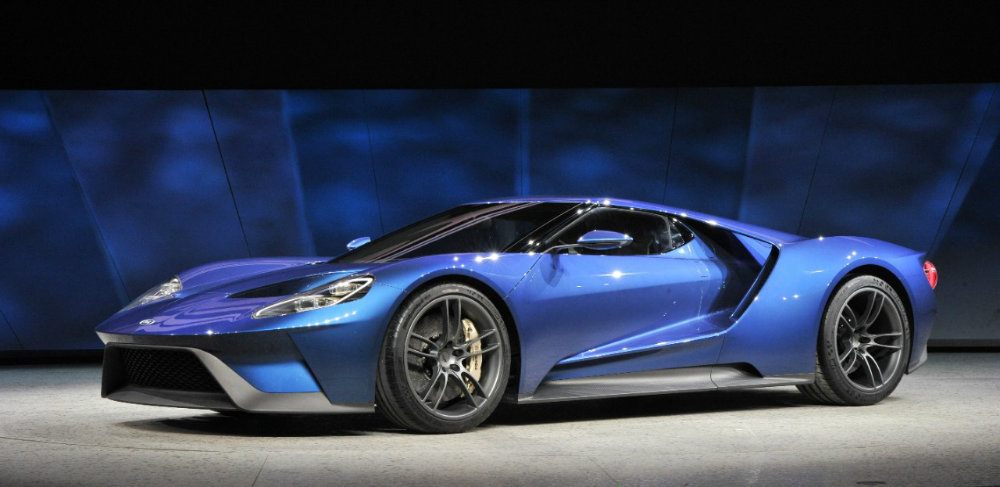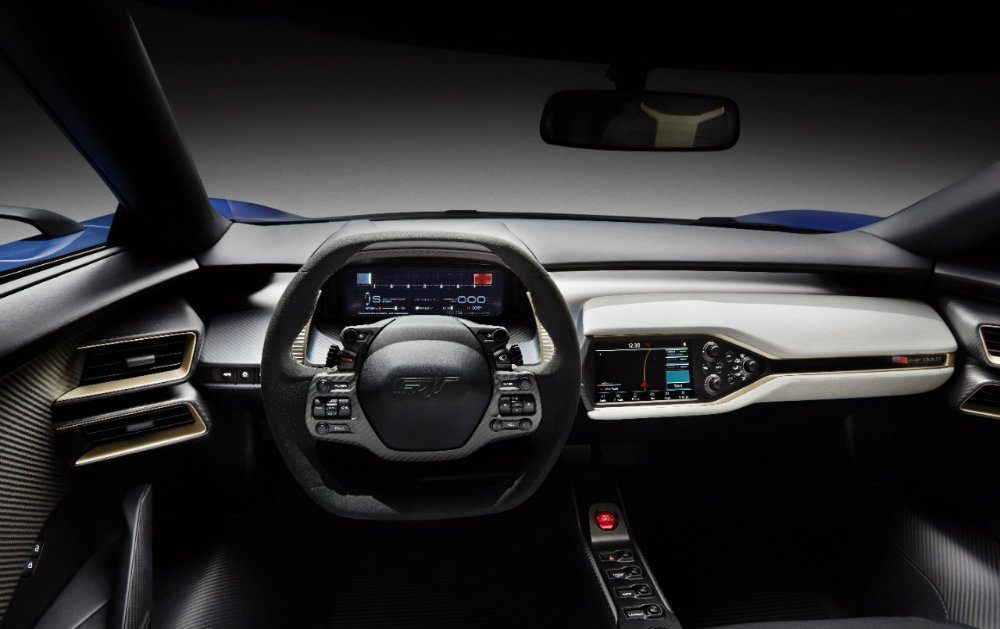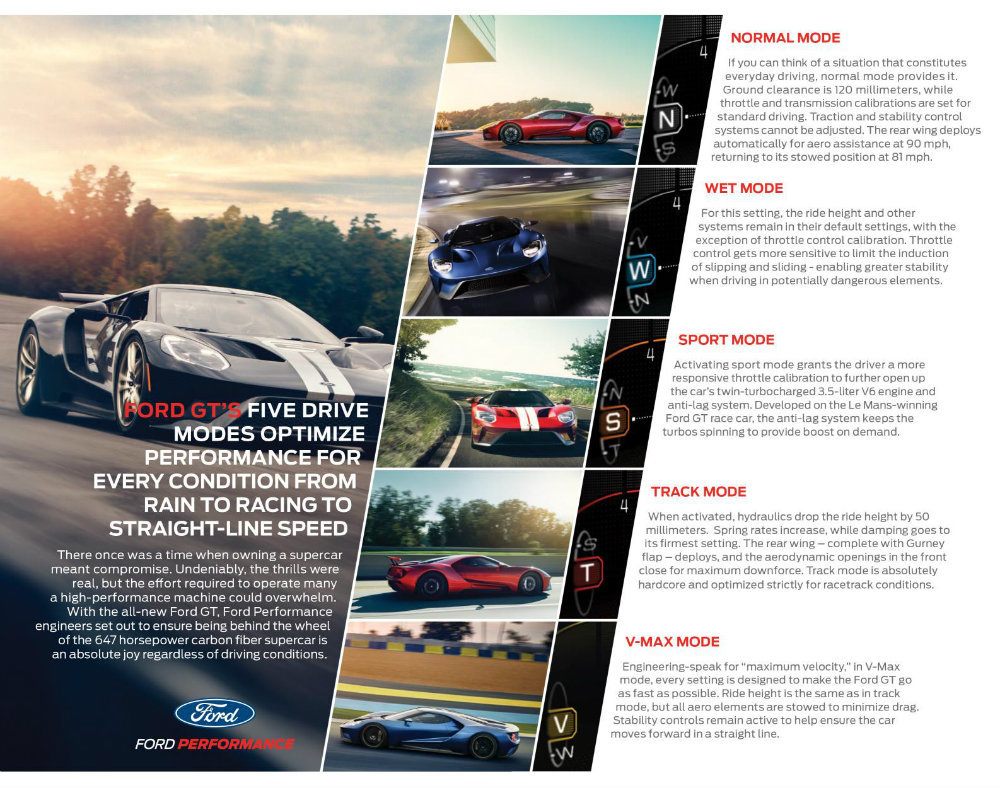You know, you really got to hand it to Ford. They’re not messing around with the GT. True, it’s not a moon-shot hypercar like McLaren’s P1 or the La Ferrari, but it’s not exactly a car to be trifled with. And, unlike it’s racing ancestor, it’s performance is not 80% big engine (like the Mk. 2).
The current Ford GT is, through and through, a well thought out supercar, complete with a competition variant.
Evolving Performance
There was a time, back around 1970, where supercars, by and large, were a real pain to live with. Many compromises were forced upon the owner of, say, a Maserati Bora. You sat at an uncomfortable angle. Reliability was iffy. Air conditioning? Well, they had a knob that said that. Visibility was only good in one direction (forward). Performance was great but drivability could be tortuously bad.
Fast forward to the present day, and the 2017 Ford GT has none of these issues. In terms of everyday usability, it’s hard to distinguish the GT from a Mustang. Yes, the GT cranks out 647 horsepower and is built from carbon fiber, but it’s easy to drive in a variety of conditions. For example, the GT has this nifty little trick up its sleeve with five selectable driving modes. This is sort of Ford’s equivalent of Ferrari’s manettino. A bunch of suspension, engine, aero, and differential settings are stored in an on-board computer and, at the punch of a button, you can access and change them on the fly.
“Switching the setting changes electronic, mechanical, and aerodynamic elements,” explained Nick Terzes, Ford GT Engineering Supervisor.
Leveraging their racing experience, Ford Performance gave each of the modes a unique instrument cluster display, so not only do you know which mode you are in at a glance, but the display also prioritizes which information elements you see to augment the overall driving experience. So you, the happy Ford GT owner, can go from a day at the track, to tooling home through light traffic and your car can handle it all at the flick of a switch. Or, more accurately, the turn of a knob on the GT’s steering wheel.

The Ford GT was introduced at the North American International Auto Show, January 12th, 2015. Photo: Ford Motor Company.
Normal Mode
When the 2017 Ford GT is in Normal mode, all the settings are oriented around everyday driving situations. Ground clearance is set at 120 millimeters, so you won’t gronk the front end as easily. Throttle and transmission calibrations are set for “standard driving,” while the traction and stability control systems are set specifically and cannot be adjusted. At 90 mph, the rear wing deploys automatically for greater downforce, returning to its stowed position at 81 mph.
The wing still deploys as an airbrake if the car’s sensors detect aggressive braking.
You can also choose a comfort suspension setting in both Normal and Wet modes. Going with the comfort setting softens the car’s ride on bumpy roads by fine-tuning compression and rebound without compromising overall control.
Wet Mode
Here the Ford GT’s ride height and other systems remain in their default, Normal setting, with the notable omission of throttle control calibration. In Wet mode, the throttle control is tweaked to limit slipping and sliding, giving the GT greater stability in potentially dangerous elements. In other words, you won’t be spinning the tires and slewing the car all over the place like a ham-fisted teenager.
Sport Mode
Sport mode (or as we like to call it, Automoblog mode) provides snappier throttle response. It’s calibrated so the GT’s twin-turbocharged 3.5-liter V6 engine and anti-lag system are as responsive as a naturally aspirated mill. Developed on the Le Mans-winning Ford GT race car, the anti-lag system keeps the turbo spinning so you, the lucky GT driver, has boost on demand. In Sport mode you still get 120 millimeters of ground clearance, but everything else has been tweaked towards the upper right hand of the performance envelope.
Comfort? That’s gone from the available settings. But, and this is a big but, AdvanceTrac stability and traction control are now driver-adjustable so you technically get three additional settings. The GT will now give you more slip, yaw, and oversteer so you can push harder and slide the car around more (i.e. have more fun). Things get more aggressive in Sport mode; slight throttle changes result in faster acceleration, and gear changes fire off faster with clutch engagement happening very quickly for max acceleration.
Track Mode
After Sport mode, we come to Track mode. Ford says thusly: “Track mode is absolutely hardcore and optimized strictly for race conditions.” And they are not even close to joking. Put the transmission into “park” and turn the knob to activate hydraulics that drop ride height another 50 millimeters. Spring rates go up and damping goes to the firmest setting. The rear wing deploys and, at the nose, the aerodynamic openings close for all-out downforce.
All of this happens in under two seconds and, come on, will probably look and sound really cool!
V-Max Mode
And finally, we come to V-Max mode. V-Max is a term you usually find in the aerospace world and it means, reasonably enough, “Velocity Maximum,” or in a more colloquial form: “As fast as you can go before the whole shebang flies apart at the seams.”
Obviously, and this goes without saying, but I have to say it because there are a ridiculous number of knuckle-dragging Neanderthals out there: V-Max mode is only, only, ONLY for closed circuit track use. Don’t be a complete chimp and use it on the street. Okay?
V-Max mode tunes everything to make the Ford GT go as fast as possible. It’s Chuck Yeager time. Go punch a hole in the sky without leaving the ground. You can’t get into V-Max mode on the go, however. Like Track mode, going into V-Max requires the transmission be in park. Ride height stays the same as Track mode, but all aero elements are stowed to minimize drag.
Stability controls remain active to help ensure the car moves forward in a straight line and, without that rear wing up, you’re going to want as much stability as Mr. Newton can provide without Mr. Bernoulli’s assistance.
Launch Control
The Ford GT also includes an improved launch control system for optimum traction and the perfect start every time. Launch control is triggered via steering wheel controls in the instrument panel menu. Ford cautions how the launch control is “designed for track use,” so be a good boy or girl and only use it there. The launch control system can be used in all of the available driving modes, except for Wet.
When activated, a white “LC” shows up on the instrument cluster. From there, the driver holds down the brake with their left foot and mashes – okay “fully depresses” the gas – with their right foot. When the car is ready, the “LC” light turns from white to green, you lift your left foot off the brake, and BANG you’re down the straightaway, ricky-tick!
We, the long serving Automoblog staff, would like to offer our services to Ford to really wring out the new GT and get them some top notch feedback. We’ll take one in red, one in white, and one in blue. I’ll take the blue one. Ford reps, please contact our Managing Editor, Carl Anthony, at 1 Automoblog Tower for shipping info. In the meantime, the graphic below from Ford explains more about the individual driving modes.
Tony Borroz has spent his entire life racing antique and sports cars. He means well, even if he has a bias towards lighter, agile cars rather than big engine muscle cars or family sedans.
Photos & Source: Ford Motor Company.
from Automoblog.net http://www.automoblog.net/2017/04/01/2017-ford-gt-one-car-five-personalities/
via IFTTT
from Tumblr http://peternpalmer.tumblr.com/post/159074101116
via IFTTT



No comments:
Post a Comment